
During a volcanic eruption, lava, tephra (ash, lapilli, volcanic bombs and blocks), and various gases are expelled from a volcanic vent or fissure. Several types of volcanic eruptions have been distinguished by volcanologists. These are often named after famous volcanoes where that type of behavior has been observed. Some volcanoes may exhibit only one characteristic type of eruption during a period of activity, while others may display an entire sequence of types all in one eruptive series.
There are three different meta types of eruptions. The most well-observed are magmatic eruptions, which involve the decompression of gas within magma that propels it forward. Phreatomagmatic eruptions are another type of volcanic eruption, driven by the compression of gas within magma, the direct opposite of the process powering magmatic activity. The last eruptive metatype is the phreatic eruption, which is driven by the superheating of steam via contact with magma; these eruptive types often exhibit no magmatic release, instead causing the granulation of existing rock.
Within these wide-defining eruptive types are several subtypes. The weakest are Hawaiian and submarine, then Strombolian, followed by Vulcanian and Surtseyan. The stronger eruptive types are Pelean eruptions, followed by Plinian eruptions; the strongest eruptions are called “Ultra Plinian.” Subglacial and phreatic eruptions are defined by their eruptive mechanism, and vary in strength. An important measure of eruptive strength is Volcanic Explosivity Index (VEI), an order of magnitude scale ranging from 0 to 8 that often correlates to eruptive types.
Eruption mechanisms
Volcanic eruptions arise through three main mechanisms:
- Gas release under decompression causing magmatic eruptions
- Thermal contraction from chilling on contact with water causing phreatomagmatic eruptions
- Ejection of entrained particles during steam eruptions causing phreatic eruptions
There are two types of eruptions in terms of activity, explosive eruptions and effusive eruptions. Explosive eruptions are characterized by gas-driven explosions that propels magma and tephra.Effusive eruptions, meanwhile, are characterized by the outpouring of lava without significant explosive eruption.
Volcanic eruptions vary widely in strength. On the one extreme there are effusive Hawaiian eruptions, which are characterized by lava fountains and fluid lava flows, which are typically not very dangerous. On the other extreme, Plinian eruptions are large, violent, and highly dangerous explosive events. Volcanoes are not bound to one eruptive style, and frequently display many different types, both passive and explosive, even the span of a single eruptive cycle. Volcanoes do not always erupt vertically from a single crater near their peak, either. Some volcanoes exhibit lateral and fissure eruptions. Notably, many Hawaiian eruptions start from rift zones, and some of the strongest Surtseyan eruptions develop along fracture zones. Scientists believed that pulses of magma mixed together in the chamber before climbing upward—a process estimated to take several thousands of years. But Columbia University volcanologists found that the eruption of Costa Rica’s Irazú Volcano in 1963 was likely triggered by magma that took a nonstop route from the mantle over just a few months.
Magmatic eruptions
Magmatic eruptions produce juvenile clasts during explosive decompression from gas release. They range in intensity from the relatively small lava fountains on Hawaii to catastrophic Ultra Plinian eruption columns more than 30 km (19 mi) high, bigger than the eruption of Mount Vesuvius in 79 that buried Pompeii.
Hawaiian
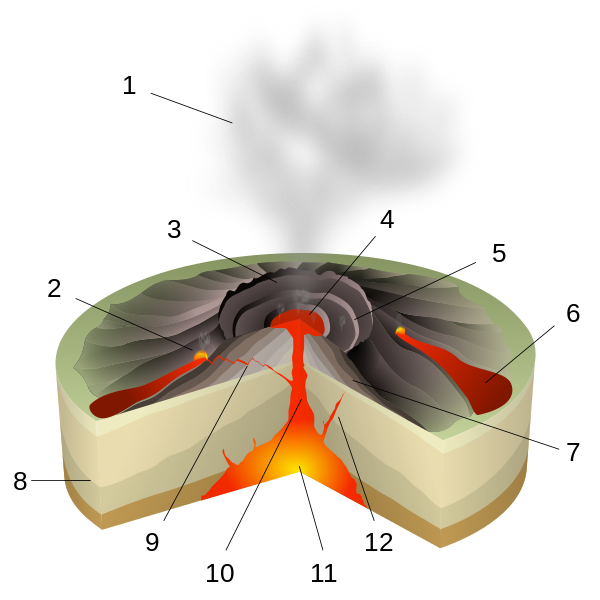
Hawaiian eruptions are a type of volcanic eruption, named after the Hawaiian volcanoes with which this eruptive type is hallmark. Hawaiian eruptions are the calmest types of volcanic events, characterized by the effusive eruption of very fluid basalt-type lavas with low gaseous content. The volume of ejected material from Hawaiian eruptions is less than half of that found in other eruptive types. Steady production of small amounts of lava builds up the large, broad form of a shield volcano. Eruptions are not centralized at the main summit as with other volcanic types, and often occur at vents around the summit and from fissure vents radiating out of the center.
Hawaiian eruptions often begin as a line of vent eruptions along a fissure vent, a so-called “curtain of fire.” These die down as the lava begins to concentrate at a few of the vents. Central-vent eruptions, meanwhile, often take the form of large lava fountains (both continuous and sporadic), which can reach heights of hundreds of meters or more. The particles from lava fountains usually cool in the air before hitting the ground, resulting in the accumulation of cindery scoria fragments; however, when the air is especially thick with clasts, they cannot cool off fast enough due to the surrounding heat, and hit the ground still hot, the accumulation of which forms spatter cones. If eruptive rates are high enough, they may even form splatter-fed lava flows. Hawaiian eruptions are often extremely long lived; Pu’u O’o, a cinder cone of Kilauea, has been erupting continuously since 1983. Another Hawaiian volcanic feature is the formation of active lava lakes, self-maintaining pools of raw lava with a thin crust of semi-cooled rock; there are currently only 5 such lakes in the world, and the one at Kīlauea’s Kupaianaha vent is one of them.
Strombolian
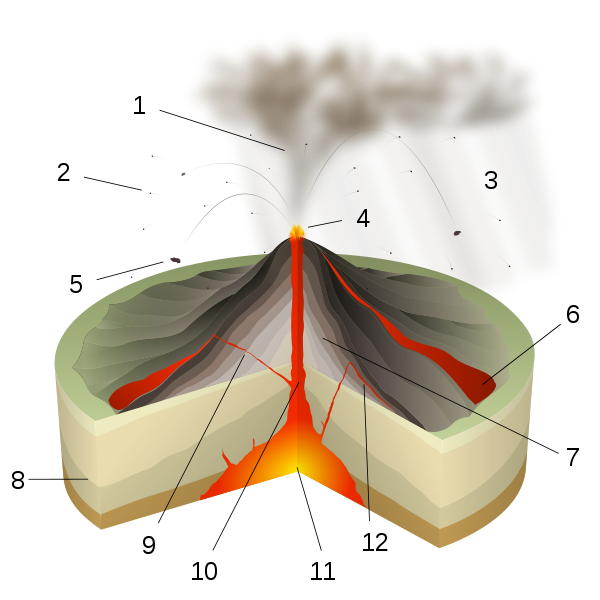
Strombolian eruptions are a type of volcanic eruption, named after the volcano Stromboli, which has been erupting continuously for centuries. Strombolian eruptions are driven by the bursting of gas bubbles within the magma. These gas bubbles within the magma accumulate and coalesce into large bubbles, called gas slugs. These grow large enough to rise through the lava column. Upon reaching the surface, the difference in air pressure causes the bubble to burst with a loud pop, throwing magma in the air in a way similar to a soap bubble. Because of the high gas pressures associated with the lavas, continued activity is generally in the form of episodic explosive eruptions accompanied by the distinctive loud blasts. During eruptions, these blasts occur as often as every few minutes.
The term “Strombolian” has been used indiscriminately to describe a wide variety of volcanic eruptions, varying from small volcanic blasts to large eruptive columns. In reality, true Strombolian eruptions are characterized by short-lived and explosive eruptions of lavas with intermediate viscosity, often ejected high into the air. Columns can measure hundreds of meters in height. The lavas formed by Strombolian eruptions are a form of relatively viscous basaltic lava, and its end product is mostly scoria. The relative passivity of Strombolian eruptions, and its non-damaging nature to its source vent allow Strombolian eruptions to continue unabated for thousands of years, and also makes it one of the least dangerous eruptive types.
Strombolian eruptions eject volcanic bombs and lapilli fragments that travel in parabolic paths before landing around their source vent. The steady accumulation of small fragments builds cinder cones composed completely of basaltic pyroclasts. This form of accumulation tends to result in well-ordered rings of tephra.
Strombolian eruptions are similar to Hawaiian eruptions, but there are differences. Strombolian eruptions are noisier, produce no sustained eruptive columns, do not produce some volcanic products associated with Hawaiian volcanism (specifically Pele’s tears and Pele’s hair), and produce fewer molten lava flows (although the eruptive material does tend to form small rivulets).
Vulcanian
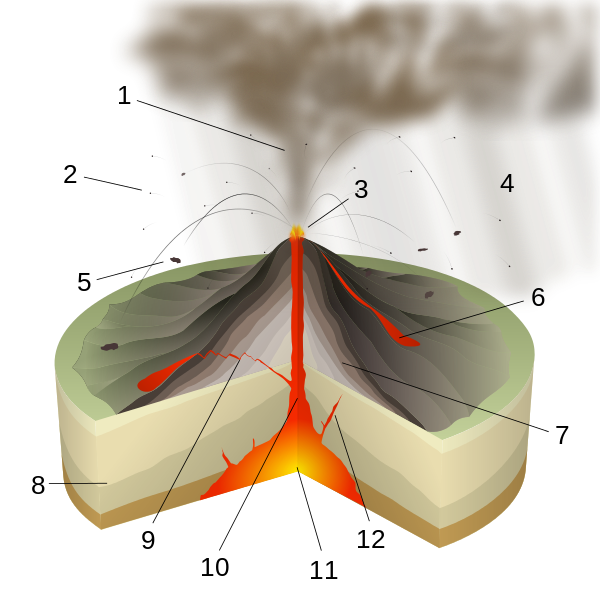
Vulcanian eruptions are a type of volcanic eruption, named after the volcano Vulcano, which means the word Volcano. It was named so following Giuseppe Mercalli’s observations of its 1888-1890 eruptions. In Vulcanian eruptions, highly viscous magma within the volcano make it difficult for vesiculate gases to escape. Similar to Strombolian eruptions, this leads to the buildup of high gas pressure, eventually popping the cap holding the magma down and resulting in an explosive eruption. However, unlike Strombolian eruptions, ejected lava fragments are not aerodynamic; this is due to the higher viscosity of Vulcanian magma and the greater incorporation of crystalline material broken off from the former cap. They are also more explosive than their Strombolian counterparts, with eruptive columns often reaching between 5 and 10 km (3 and 6 mi) high. Lastly, Vulcanian deposits are andesitic to dacitic rather than basaltic.
Initial Vulcanian activity is characterized by a series of short-lived explosions, lasting a few minutes to a few hours and typified by the ejection of volcanic bombs and blocks. These eruptions wear down the lava dome holding the magma down, and it disintegrates, leading to much more quiet and continuous eruptions. Thus an early sign of future Vulcanian activity is lava dome growth, and its collapse generates an outpouring of pyroclastic material down the volcano’s slope.
Peléan
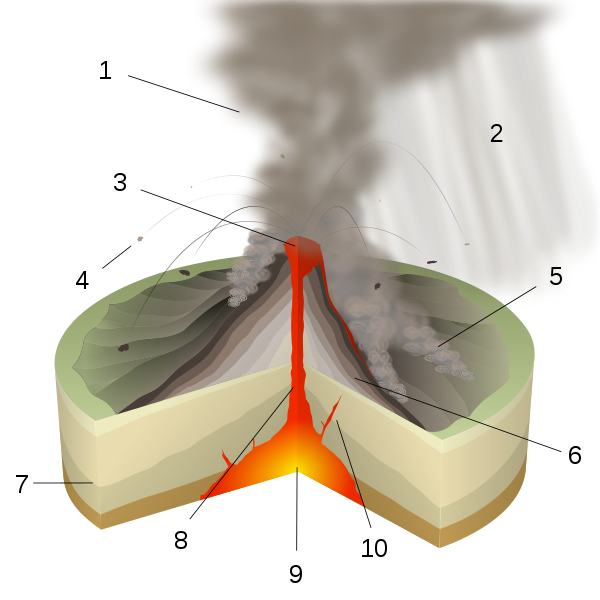
Peléan eruptions (or nuée ardente) are a type of volcanic eruption, named after the volcano Mount Pelée in Martinique, the site of a massive Peléan eruption in 1902 that is one of the worst natural disasters in history. In Peléan eruptions, a large amount of gas, dust, ash, and lava fragments are blown out the volcano’s central crater, driven by the collapse of rhyolite, dacite, and andesite lava dome collapses that often create large eruptive columns. An early sign of a coming eruption is the growth of a so-called Peléan or lava spine, a bulge in the volcano’s summit preempting its total collapse. The material collapses upon itself, forming a fast-moving pyroclastic flow (known as a block-and-ash flow) that moves down the side of the mountain at tremendous speeds, often over 150 km (93 mi) per hour. These massive landslides make Peléan eruptions one of the most dangerous in the world, capable of tearing through populated areas and causing massive loss of life. The 1902 eruption of Mount Pelée caused tremendous destruction, killing more than 30,000 people and competely destroying the town of St. Pierre, the worst volcanic event in the 20th century.
Peléan eruptions are characterized most prominently by the incandescent pyroclastic flows that they drive. The mechanics of a Peléan eruption are very similar to that of a Vulcanian eruption, except that in Peléan eruptions the volcano’s structure is able to withstand more pressure, hence the eruption occurs as one large explosion rather than several smaller ones.
Plinian
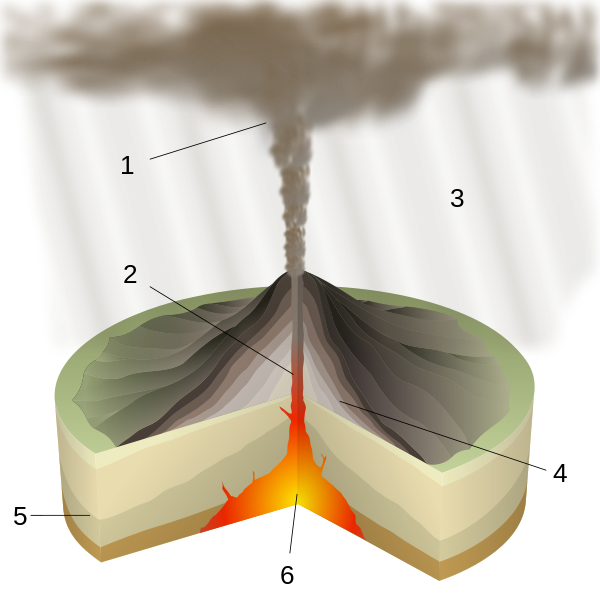
Plinian eruptions (or Vesuvian) are a type of volcanic eruption, named for the historical eruption of Mount Vesuvius in 79 of Mount Vesuvius that buried the Roman towns of Pompeii and Herculaneum, and specifically for its chronicler Pliny the Younger. The process powering Plinian eruptions starts in the magma chamber, where dissolved volatile gases are stored in the magma. The gases vesiculate and accumulate as they rise through the magma conduit. These bubbles agglutinate and once they reach a certain size (about 75% of the total volume of the magma conduit) they explode. The narrow confines of the conduit force the gases and associated magma up, forming an eruptive column. Eruption velocity is controlled by the gas contents of the column, and low-strength surface rocks commonly crack under the pressure of the eruption, forming a flared outgoing structure that pushes the gases even faster.
These massive eruptive columns are the distinctive feature of a Plinian eruption, and reach up 2 to 45 km (1 to 28 mi) into the atmosphere. The densest part of the plume, directly above the volcano, is driven internally by gas expansion. As it reaches higher into the air the plume expands and becomes less dense, convection and thermal expansion of volcanic ash drive it even further up into the stratosphere. At the top of the plume, powerful prevailing winds drive the plume in a direction away from the volcano.
Plinian eruptions are similar to both Vulcanian and Strombolian eruptions, except that rather than creating discrete explosive events, Plinian eruptions form sustained eruptive columns. They are also similar to Hawaiian lava fountains in that both eruptive types produce sustained eruption columns maintained by the growth of bubbles that move up at about the same speed as the magma surrounding them.
Phreatomagmatic eruptions
Phreatomagmatic eruptions are eruptions that arise from interactions between water and magma. They are driven from thermal contraction (as opposed to magmatic eruptions, which are driven by thermal expansion) of magma when it comes in contact with water. This temperature difference between the two causes violent water-lava interactions that make up the eruption. The products of phreatomagmatic eruptions are believed to be more regular in shape and finer grained than the products of magmatic eruptions because of the differences in eruptive mechanisms.
There is debate about the exact nature of phreatomagmatic eruptions, and some scientists believe that fuel-coolant reactions may be more critical to the explosive nature than thermal contraction. Fuel coolant reactions may fragment the volcanic material by propagating stress waves, widening cracks and increasing surface area that ultimetly lead to rapid cooling and explosive contraction-driven eruptions.
Surtseyan
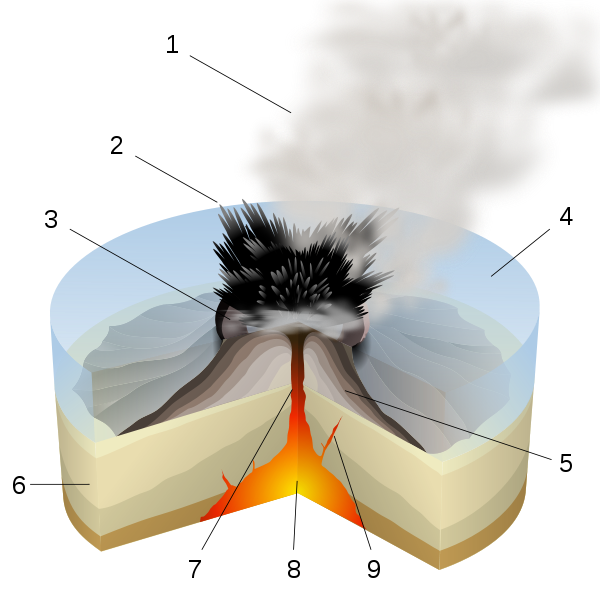
A Surtseyan eruption (or hydrovolcanic) is a type of volcanic eruption caused by shallow-water interactions between water and lava, named so after its most famous example, the eruption and formation of the island of Surtsey off the coast of Iceland in 1963. Surtseyan eruptions are the “wet” equivalent of ground-based Strombolian eruptions, but because of where they are taking place they are much more explosive. This is because as water is heated by lava, it flashes in steam and expands violently, fragmenting the magma it is in contact with into fine-grained ash. Surtseyan eruptions are the hallmark of shallow-water volcanic oceanic islands, however they are not specifically confined to them. Surtseyan eruptions can happen on land as well, and are caused by rising magma that comes into contact with an aquifer (water-bearing rock formation) at shallow levels under the volcano. The products of Surtseyan eruptions are generally oxidized palagonite basalts (though andesitic eruptions do occur, albeit rarely), and like Strombolian eruptions Surtseyan eruptions are generally continuous or otherwise rhythmic.
Submarine
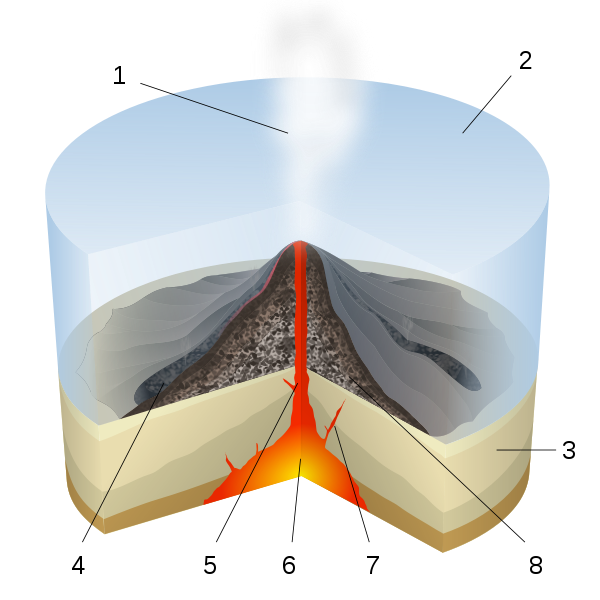
Submarine eruptions are a type of volcanic eruption that occurs underwater. An estimated 75% of the total volcanic eruptive volume is generated by submarine eruptions near mid ocean ridges alone, however because of the problems associated with detecting deep sea volcanics, they remained virtually unknown until advances in the 1990s made it possible to observe them.
Submarine eruptions may produce seamounts which may break the surface to form volcanic islands and island chains.
Submarine volcanism is driven by various processes. Volcanoes near plate boundaries and mid-ocean ridges are built by the decompression melting of mantle rock that rises on an upwelling portion of a convection cell to the crustal surface. Eruptions associated with subducting zones, meanwhile, are driven by subducting plates that add volatiles to the rising plate, lowering its melting point. Each process generates different rock; mid-ocean ridge volcanics are primarily basaltic, whereas subduction flows are mostly calc-alkaline, and more explosive and viscous.
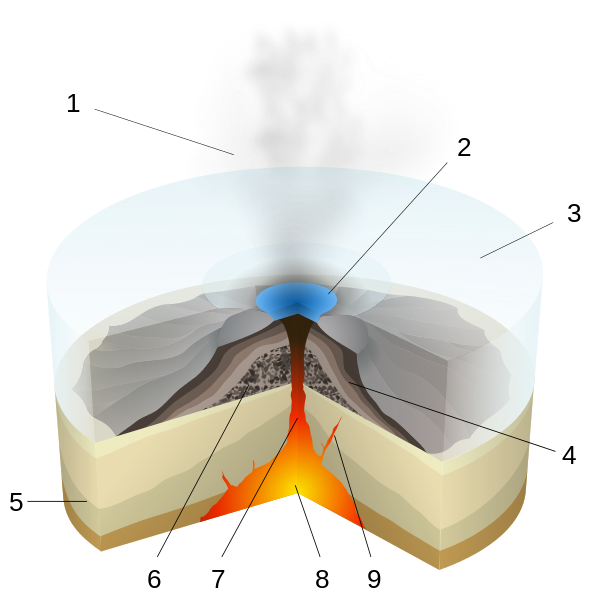
Subglacial
Subglacial eruptions are a type of volcanic eruption characterized by interactions between lava and ice, often under a glacier. The nature of glaciovolcanism dictates that it occurs at areas of high latitude and high altitude. It has been suggested that subglacial volcanoes that are not actively erupting often dump heat into the ice covering them, producing meltwater. This meltwater mix means that subglacial eruptions often generate dangerous jökulhlaups (floods) and lahars.
The study of glaciovolcanism is still a relatively new field. Early accounts described the unusual flat-topped steep-sided volcanoes (called tuyas) in Iceland that were suggested to have formed from eruptions below ice. The first English-language paper on the subject was published in 1947 by William Henry Mathews, describing the Tuya Butte field in northwest British Columbia, Canada. The eruptive process that builds these structures, originally inferred in the paper, begins with volcanic growth below the glacier. At first the eruptions resemble those that occur in the deep sea, forming piles of pillow lava at the base of the volcanic structure. Some of the lava shatters when it comes in contact with the cold ice, forming a glassy breccia called hyaloclastite. After a while the ice finally melts into a lake, and the more explosive eruptions of Surtseyan activity begins, building up flanks made up of mostly hyaloclastite. Eventually the lake boils off from continued volcanism, and the lava flows become more effusive and thicken as the lava cools much more slowly, often forming columnar jointing. Well-preserved tuyas show all of these stages, for example Hjorleifshofdi in Iceland.
Products of volcano-ice interactions stand as various structures, whose shape is dependent on complex eruptive and environmental interactions. Glacial volcanism is a good indicator of past ice distribution, making it an important climatic marker. Since they are imbedded in ice, as ice retracts worldwide there are concerns that tuyas and other structures may destabalize, resulting in mass landslides. Evidence of volcanic-glacial interactions are evident in Iceland and parts of British Columbia, and it’s even possible that they play a role in deglaciation.
Phreatic eruptions
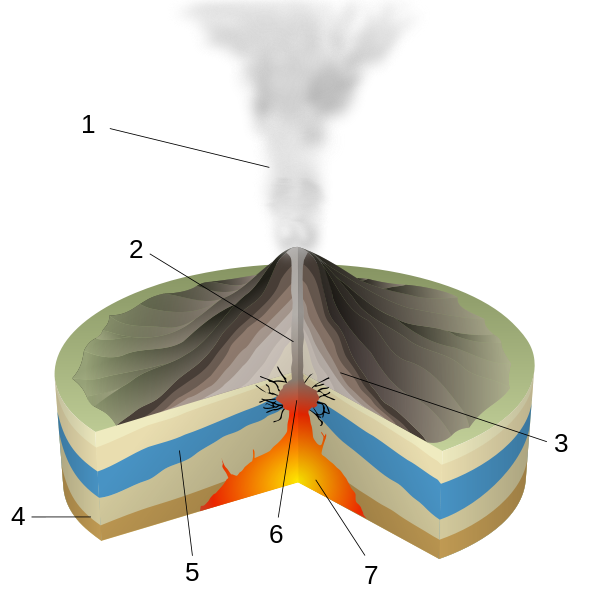
Phreatic eruptions (or steam-blast eruptions) are a type of eruption driven by the expansion of steam. When cold ground or surface water come into contact with hot rock or magma it superheats and explodes, fracturing the surrounding rock and thrusting out a mixture of steam, water, ash, volcanic bombs, and volcanic blocks. The distinguishing feature of phreatic explosions is that they only blast out fragments of pre-existing solid rock from the volcanic conduit; no new magma is erupted. Because they are driven by the cracking of rock stata under pressure, phreatic activity does not always result in an eruption; if the rock face is strong enough to withstand the explosive force, outright eruptions may not occur, although cracks in the rock will probably develop and weaken it, furthering future eruptions.
Often a precursor of future volcanic activity, phreatic eruptions are generally weak, although there have been exceptions. Some phreatic events may be triggered by earthquake activity, another volcanic precursor, and they may also travel along dike lines. Phreatic eruptions form base surges, lahars, avalanches, and volcanic block “rain.” They may also release deadly toxic gas able to suffocate anyone in range of the eruption.
Photos
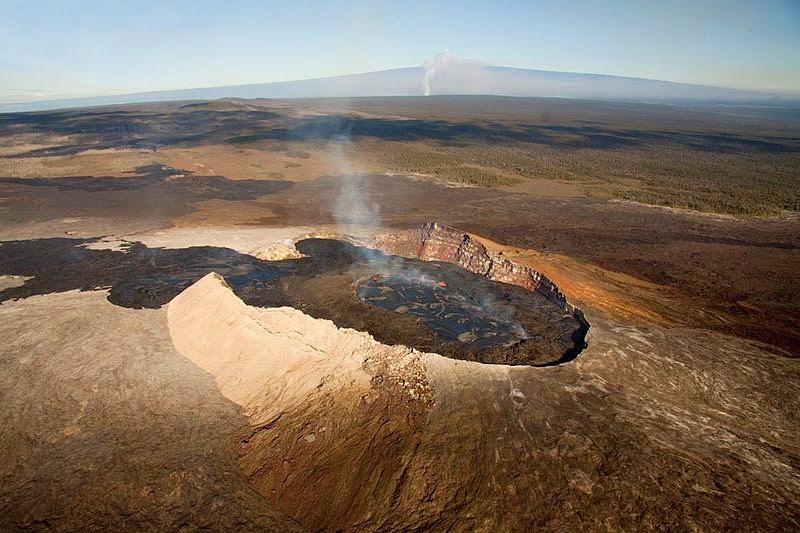
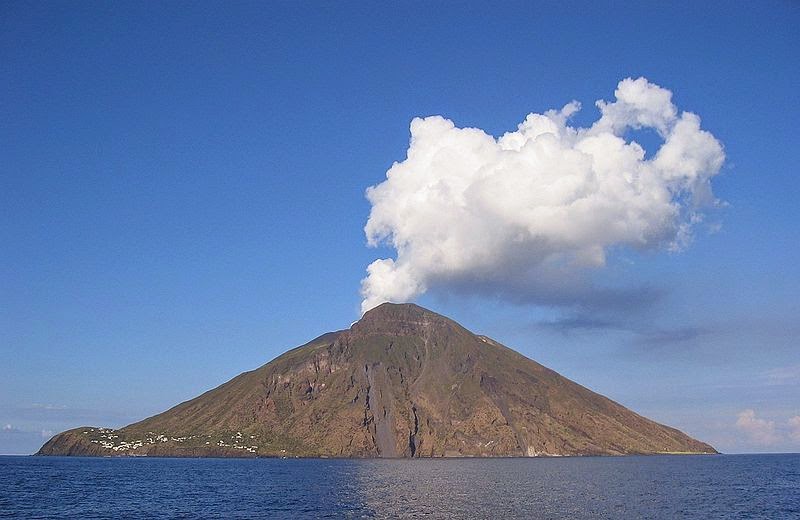
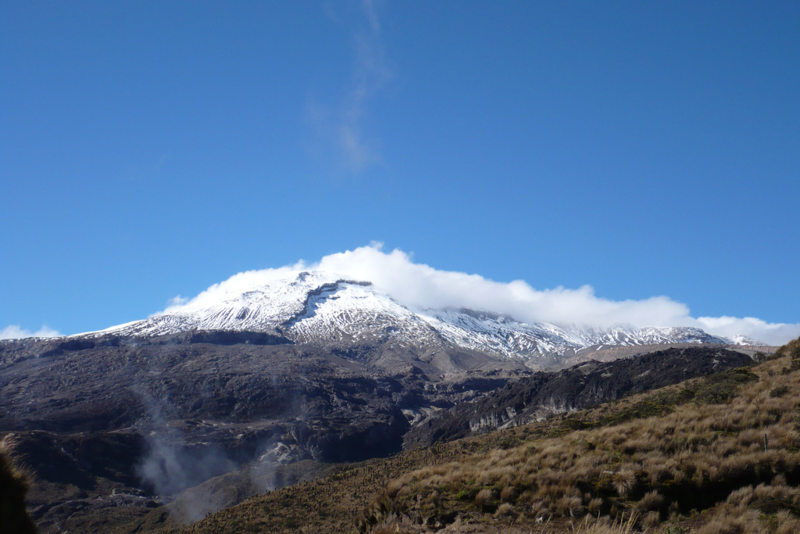
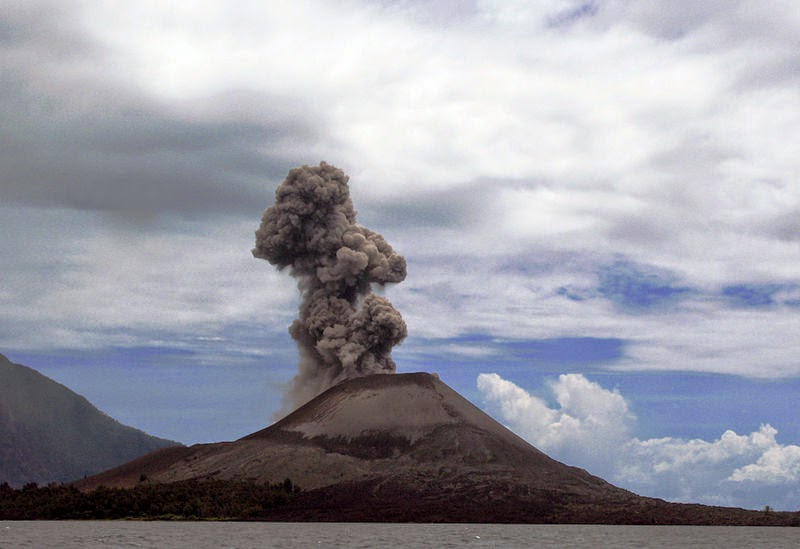
Reference:
USGS : Types of Volcanic Eruptions
University of Hawai‘i : HAWAIIAN ERUPTIONS
Wikipedia: Types of volcanic eruptions
University of California : VOLCANIC ACTIVITY AND ERUPTIONS









